30 October, 2004
Drilling dive holes
Today, after having seen the divers use dive holes, I finally got to see how the drilled holes, like the one at Cinder Cones, are made. My flight was delayed yet again. It was originally scheduled for 1345 (1:45 pm) but has been delayed until 1745 (5:45 pm).
We met the driller, Tom, and his assistant for the day, Heidi, at 8:15 this morning. The drill rig is pulled by a bulldozer and features a pivoting arm with a drill bit that's about four feet in diameter.
Our first stop was the far side of Hut Point, where we walked out to Shackleton's Discovery Hut on the first day at McMurdo. Andrew used the GPS to find the location where the hole was drilled last year. However, the ice was so criss-crossed with cracks, there didn't appear to be anywhere that the drill rig could safely make a hole. We moved on to another part of the ice.
At the next potential dive site, right off the station, there were some big piles of snow. Tom began moving aside some of the piles to clear the ice. A pickup truck pulled up and the driver asked what we were doing. Apparently, he was afraid that the area would flood when the hole was drilled. A lot of water comes up when the drill finally breaks all the way through the ice. So that hole will have to wait until they get approval to drill.
Kathy needs to get some mud samples over at the jetty, but the existing hole is quite far from the area she would be collecting them. This would mean a long and exhausting swim carrying heavy buckets of mud. She found a place that would be good for drilling a new hole, but the way that the drill rig would have to come had a big crack across it, so that was not going to happen either.
This was starting to get more difficult than expected! Three strikes so far. But the next area looked good, and there was a good area to make two holes at the sites Outfall South A and B.
First, Tom had to clear the ice of snow, of which there was two to three feet. Next, he braced the trailer with the drill and lowered the arm. He drilled down into the ice, then pulled the drill back up. It came up loaded with snowy ground ice and chunks. Mike, Andrew, and Heidi were waiting with shovels. When Tom spun the drill, which knocked all the snowy ice off it, they made channels in the ice with the shovels. The drill-lift-shovel process was repeated about 15 times, and finally, water came pouring out of the hole. I had to jump up to get of the way, and still got water up over my ankles. Fortunately, it wasn't a problem with the bunny boots! Tom drilled a few more times and water continued to gush out of the hole.
We repeated the process with the other nearby hole, then went to lunch. We had to mark the area with black flags because a two-foot-deep trench had now been dug across one of the roads for tracked vehicles (such as the Mattrack, Pisten Bully, Hagglund, etc).
After lunch, Tom scraped the snow away from the holes and we proceeded to clear them out with shovels and the dip net. Soon we had two holes all clear! We put cookies over them, then watched while Tom drilled one more hole, This time a grader was helping clear the snow away from the hole.
One very cool thing we saw today was our first skua. Although we've seen a few seals, and I went out to the penguin ranch, there have been no other animals on land, the ice, or in the air. Skuas are big gull-like birds. They're famous for being scavengers and are the ones that steal food from your hand if you're trying to eat and walk across town at the same time. Kathy compared seeing the first skua to seeing the first robin in spring.
So far, my flight out still seems to be scheduled. The plane coming from Christchurch was supposed to pass the PSR (Point of Safe Return) a few minutes ago. This is the point at which the plane had to either turn back or continue. So if the weather or visibility are bad at McMurdo, the plane has its last chance to turn around then. Beyond that point, the plane has to keep going because it won't have enough fuel to get back to Christchurch if it turns around later.
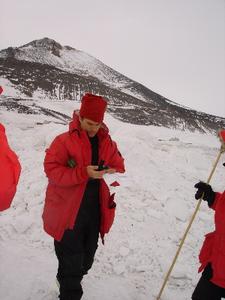
1. The first step in making a dive hole: find the location of last year's hole using the GPS (global positioning system).

2. Second step - put in a flag to mark the spot.

3. The drilling equipment.
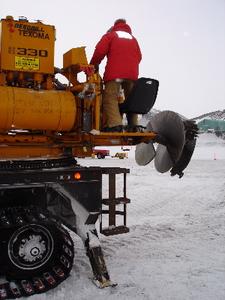
4. Tom lowers the drill.
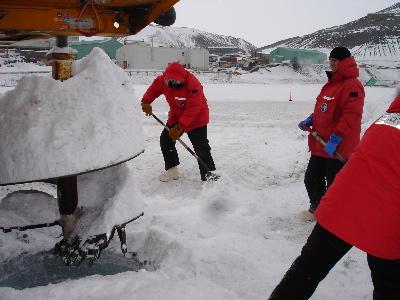
5. The drill comes up full of ice. The shovels are ready to clear channels in the snowy ice pile after the drill spins it off.
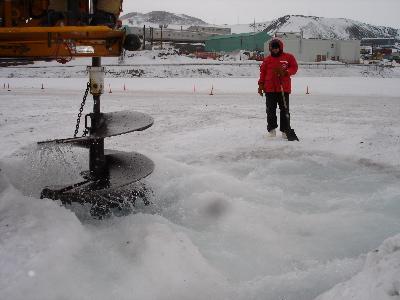
6. Spinning the drill to remove the ice from it.
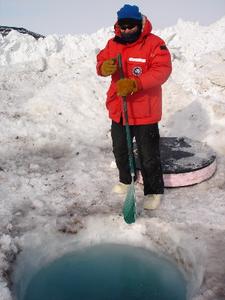
7. After a little shoveling and dipping, we have a dive hole! Toss in that cookie and move on to the next one!

8. That's a lot of water!
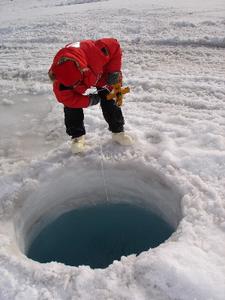
9. Kathy checks the depth under the hole. 19 meters - perfect!
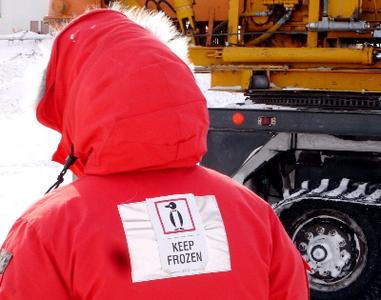
10. Heidi the GA (general assistant) is in the Antarctic spirit. She came here a few years ago on an expedition and really wanted to come back. Now she's doing her first full season as a GA, doing anything that needs to be done - shoveling ice, entering data, packing food, even working at the wastewater treatment plant!
Contact the TEA in the field at
.
If you cannot connect through your browser, copy the
TEA's e-mail address in the "To:" line of
your favorite e-mail package.
|
